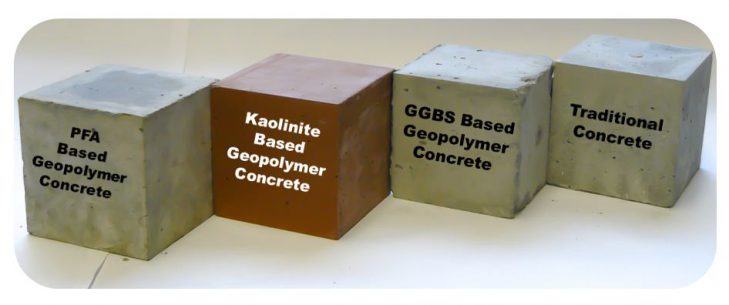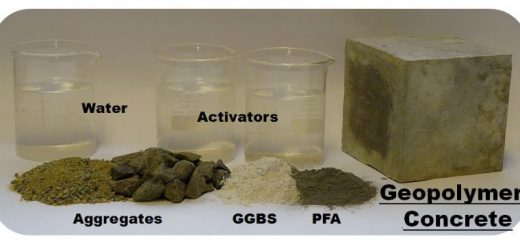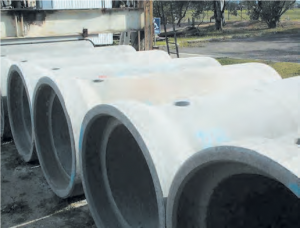It was estimated that the production of cement which is used for concrete industry increased from about 1.5 billion tons in 1995 to 2.2 billion tons in 2010. The problem is that cement industry is responsible for some of the CO2 emissions as the production of one ton of portland cement emits approximately one ton of CO2 into the atmosphere. Additionally, CO2 gas emissions participates in the global warming and the climate change.
Therefore, efforts were directed to create alternatives for the ordinary portland cement. This includes the application of supplementary cementing materials such as fly ash, silica fume, granulated blast furnace slag, and rice-husk ash.
In the regard of global warming, the geopolymer concrete has a much lower environmental footprint and could significantly reduce the CO2 emission to the atmosphere caused by the cement industry.
Geopolymer Concrete
In 1988, Davidovits proposed that an alkaline liquid could be used to react with the silicon (Si) and the aluminium (Al) in a source material of geological origin or in by-product materials such as fly ash and rice husk ash to produce binders. He gave the term “Geopolymer” to represent these binders as the chemical reaction that takes place in this case is a polymerization process.
There are two main constituents of geopolymers:
- The source materials: are based on alumina-silicate, should be rich in silicon (Si) and aluminium (Al). These could be natural minerals such as kaolinite or clays. Also, by-product materials such as fly ash, silica fume, slag, or rice-husk ash could be used as source materials.
- The alkaline liquids: are from soluble alkali metals that are usually sodium or potassium based. The most common alkaline liquid used in geopolymerization is a combination of sodium hydroxide (NaOH) or potassium hydroxide (KOH) and sodium silicate or potassium silicate.
Components Of Geopolymer Concrete
The primary difference between geopolymer concrete and Portland cement concrete is the binder. The silicon and aluminum oxides in the low-calcium fly ash reacts with the alkaline liquid to form the geopolymer paste that binds the loose coarse aggregates, fine aggregates, and other un-reacted materials together to form the geopolymer concrete.
Geopolymer concrete can be manufactured by using:
- Low-calcium fly ash or slag.
- Coarse and fine aggregates: as in the case of Portland cement concrete, the coarse and fine aggregates occupy about 75 to 80% of the mass of geopolymer concrete
- The alkaline liquid: A combination of sodium silicate solution and sodium hydroxide (NaOH) solution. The role of alkaline liquid solution is to activate the geopolymeric source materials containing Si and Al such as fly ash and GGBS.
- Extra water and a high range water reducer super plasticizer may be added to the mixture to improve the workability.

Properties of Geopolymer Concrete
Unit weight: of the low-calcium fly ash based geopolymer concrete is similar to that of portland cement concrete (varied between 2330 and 2430 kg/m3).
Compressive strength: of geopolymer concrete has been found to reach up to 70 MPa. Moreover, the concrete gains its compressive strength faster than ordinary portland cement concrete.
Creep and drying shrinkage:
Fly ash-based geopolymer concrete undergoes very little drying shrinkage (about 100 micro strains after one year) compared to 500 to 800 micro strains experienced by portland cement concrete indicating a significantly smaller value.
The creep coefficient after one year of loading for geopolymer concrete with compressive strength of 40, 47 and 57 MPa is between 0.6 and 0.7, while for geopolymer concrete with compressive strength of 67 MPa this value is between 0.4 and 0.5.
Note: Creep coefficient is defined as the ratio of creep strain to elastic strain.
Sulfate resistance:
Low-calcium fly ash based geopolymer concrete has an excellent resistance to sulfate attack. There was no damage to the surface of test specimens after exposure to sodium sulfate solution up to one year.
Fire resistance:
Tests showed that geopolymer paste (i.e. no aggregates) gains strength after exposure to high temperature and geopolymer mortars (geopolymer + sand) sometimes increase in strength and other times decrease in strength after exposure to elevated temperature of 800 0C.
Applications of Geopolymer Concrete:
Geopolymer concrete has been used for construction of pavements, retaining walls, water tanks and precast applications.
The University of Queensland’s Global Change Institute, designed by HASSELL is the world’s first building to successfully use geopolymer concrete for structural purposes. The 4 story high building, for general public use, comprises 3 suspended geopolymer concrete floors involving 33 precast panels. They are made from slag/fly ash-based geopolymer concrete.




